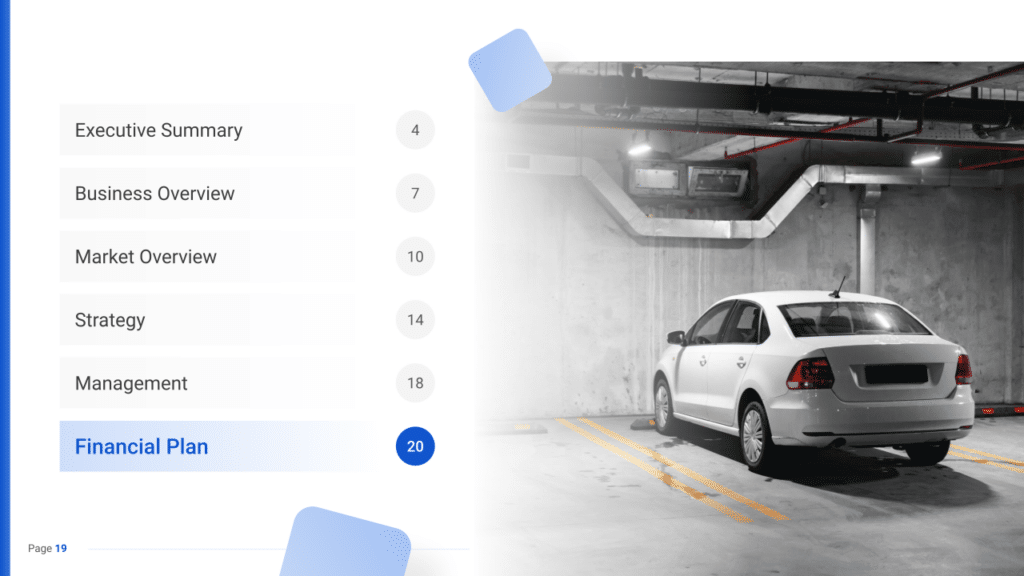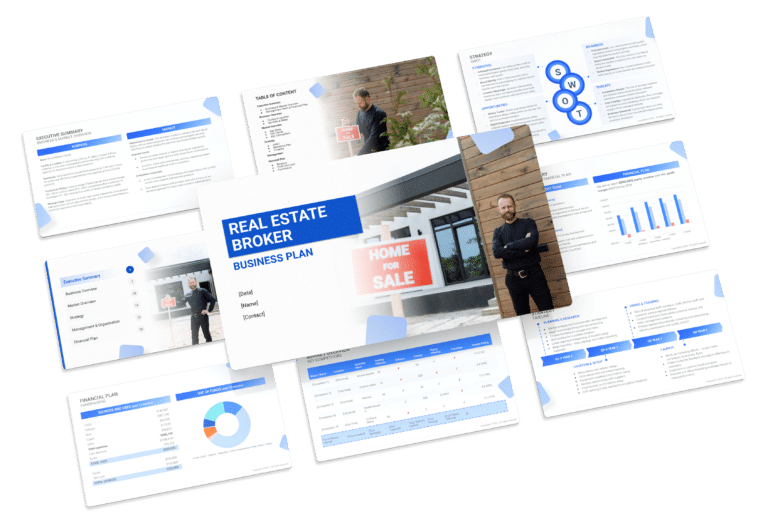Car Parking Business Plan Template & PDF Example

Creating a comprehensive business plan is crucial for launching and running a successful car parking business. This plan serves as your roadmap, detailing your vision, operational strategies, and financial plan. It helps establish your car parking business’s identity, navigate the competitive market, and secure funding for growth.
This article not only breaks down the critical components of a car parking business plan but also provides an example of a business plan to help you craft your own.
Whether you’re an experienced entrepreneur or new to the real estate industry, this guide, complete with a business plan example, lays the groundwork for turning your car parking business concept into reality. Let’s dive in!
The Plan
Our car parking business plan is crafted to encompass all crucial elements necessary for a detailed strategic approach. It details the operational framework of our parking facilities, marketing tactics, the current market landscape, competitive analysis, our management team’s expertise, and financial projections.
- Executive Summary: A quick look at our parking business, the market, our team, and our money plans.
- Business Overview: What we offer and how we do it:
- Facility & Operations: Talks about our parking spaces, where they are, and how they work, using technology to make parking easy.
- Monetization: Explains how we make money with different parking fees for hours, days, or monthly passes.
- Market Overview: Looks at the parking business scene:
- Key Stats: Shows numbers on how big the parking business is and how it’s growing.
- Key Trends: Points out new things happening in parking, like smart tech and eco-friendly moves.
- Key Competitors: Looks at other parking places nearby and what makes us different.
- Strategy: Our plan to get customers and grow:
- SWOT: Lists our strong points, weak spots, chances to do well, and things that could get in our way.
- Marketing Plan: Shares our ideas on how to tell people about our parking and keep them coming back.
- Timeline: Marks important steps from starting up to one year in.
- Management: Tells about the people leading the business and what they do.
- Financial Plan: Predicts our money situation, including how much we’ll make, how much we’ll profit, and our costs, with a plan on where we’ll get the money we need.
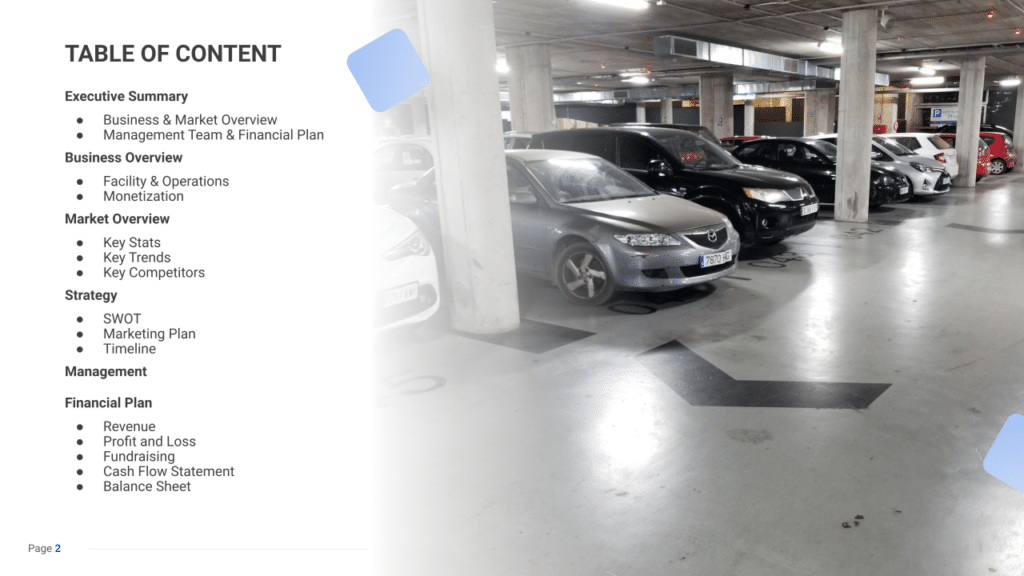
Executive Summary
The Executive Summary introduces your car parking business plan, offering a concise overview of your parking facility and its services. It should detail your market positioning, the range of parking solutions you offer (such as short-term, long-term, valet, and automated parking), its location, size, and an outline of day-to-day operations.
This section should also explore how your car parking business will integrate into the local market, including the number of direct competitors within the area, identifying who they are, and your parking facility’s unique selling points that differentiate it from these competitors.
Furthermore, you should include information about the management and co-founding team, detailing their roles and contributions to the parking facility’s success.
Additionally, a summary of your financial projections, including revenue and profits over the next five years, should be presented here to provide a clear picture of your parking business’s financial plan.
Car Parking Business Plan Executive Summary Example


Business Overview
In your executive summary’s business overview, it’s important to present clear and concise information about your car parking company. This includes the company name, the locations of your parking facilities, and an overview of your operations.
This section should also highlight your unique selling proposition (USP), which differentiates your car parking service from competitors. This could be your cutting-edge technology, exceptional customer service, or eco-friendly initiatives. The USP is vital in capturing the interest of your audience and demonstrating the unique value your car parking business offers.
Example:
“ParkEasy Solutions” operates in major urban centers, including Downtown Cityscape, Midtown District, and Riverside Area. With facilities totaling over 1,000 parking lots, ParkEasy distinguishes itself by offering a seamless parking experience through a mobile app that includes real-time lot availability, automated payments, and EV charging stations.
Market Overview
The car parking industry’s market overview should outline the industry’s size, growth trends, and dynamics. Emphasize the industry’s current valuation, projected growth rates, and key trends, such as technological advancements in parking solutions and the adoption of green practices.
Discuss the competitive landscape, identifying major competitors and explaining how your car parking business positions itself within this environment. Whether through innovative technology, superior lot locations, or value-added services, this is your opportunity to showcase how your business stands out.
Example:
ParkEasy Solutions enters a US car parking industry valued at $11.3 billion, with a projected CAGR of +1.3% through 2030. Facing competition from both local independents and national chains, ParkEasy sets itself apart with its tech-driven approach and commitment to sustainability, appealing to the modern, eco-conscious consumer.
Management Team
The expertise and background of your management team are significant assets to your business. Highlight the key qualifications and experiences of team members, such as a manager’s extensive background in urban planning or a tech officer’s expertise in smart parking solutions.
This section enhances credibility and reassures potential investors of your car parking business’s capacity for success.
Example:
ParkEasy Solutions is led by founders Jamie Chen and Alex Kim. Jamie, with a background in urban development, brings innovative space management solutions, while Alex, a software engineer, spearheads the development of ParkEasy’s proprietary parking app, enhancing customer experience and operational efficiency.
Financial Plan
Your financial plan should concisely summarize financial goals and projections, such as revenue targets and profit margins, providing a clear picture of your car parking business’s financial trajectory.
Example:
ParkEasy aims for $3.3 million in annual revenue with a 52% EBITDA margin by 2028. The strategy includes scaling up operations by acquiring key urban locations and investing in smart parking technology, driving both customer satisfaction and operational efficiency, positioning ParkEasy for significant profitability and market leadership in the car parking industry.
Business Overview
For a Car Parking Business, the Business Overview section is concisely outlined under two main headings:
Facility & Operations
Detail the parking facility’s layout, including capacity and security features. Highlight operational aspects such as technology integration for seamless entry and exit, and the inclusion of services like electric vehicle charging stations.
Monetization
Explain the pricing strategy, including hourly and subscription-based models. Mention additional revenue streams like partnerships and premium services, alongside customer loyalty schemes to promote repeat business.


Market Overview
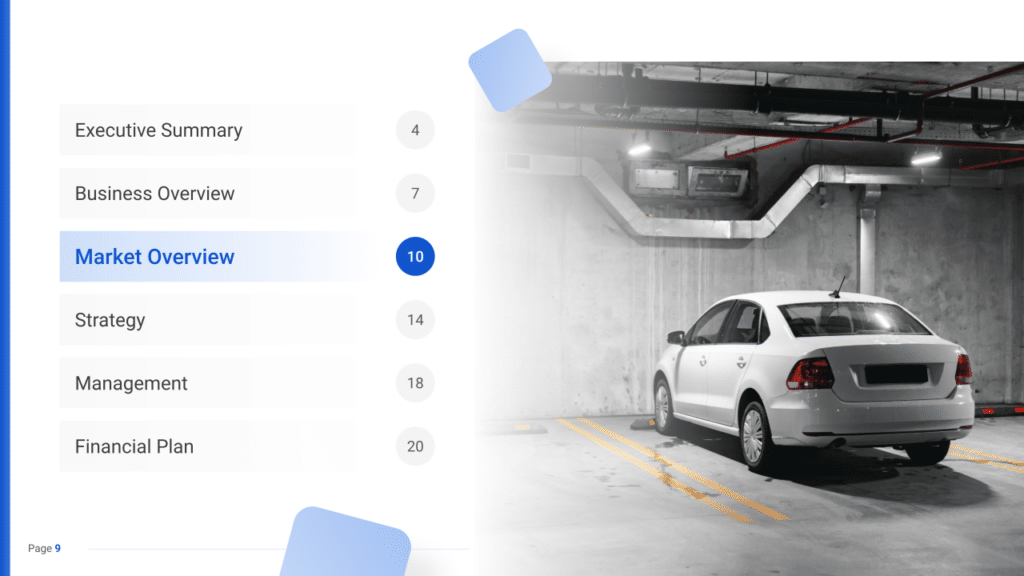
Industry size & growth
In the Market Overview of your car parking business plan, begin by evaluating the size of the parking industry and its growth prospects. This analysis is vital for grasping the market’s breadth and pinpointing opportunities for expansion.
Key market trends
Next, delve into current market trends, such as the growing need for parking solutions in densely populated urban areas, the rise of smart parking technology, and increasing consumer preference for secure, convenient parking options.
For instance, underscore the demand for parking facilities equipped with advanced security features and those offering value-added services like electric vehicle charging stations.
Competitive Landscape
A competitive analysis is not just a tool for gauging the position of your car parking business in the market and its key competitors; it’s also a fundamental component of your business plan.
This analysis helps in identifying your car parking’s unique selling points, which are essential for differentiating your business in a competitive market.
In addition, competitive analysis is integral to laying a solid foundation for your business plan. By examining various operational aspects of your competitors, you gain valuable information that ensures your business plan is robust, informed, and tailored to succeed in the current market environment.
Identifying Your Competitors in the Car Parking Sector
The first step to a strategic overview of your business’s market position is to identify your direct and indirect competitors. Start by listing down local car parking facilities, including public parking lots, private garages, and valet services. For example, if your business specializes in secure, long-term parking, your direct competitors would be other long-term parking facilities, as well as potentially airport parking services if you’re near an airport.
Leverage online tools like Google Maps to visualize the geographical spread of these competitors. Websites like Yelp and TripAdvisor, although more commonly associated with restaurants and attractions, can also provide customer reviews and ratings for parking facilities, offering a glimpse into what customers value or dislike about certain parking services.

Car Parking Business Competitors’ Strategies
Dive into the specifics of how these competing parking businesses operate:
- Parking Solutions Offered: Examine the variety of parking solutions provided. For instance, a competitor offering a valet service in addition to self-parking might attract a different clientele looking for convenience.
- Pricing Models: Look at how competitors price their services. Are they offering flat rates, hourly rates, or dynamic pricing based on demand?
- Technology Integration: Assess the use of technology, such as mobile apps for spot reservations or automated payment systems, which can significantly enhance customer convenience.
- Location and Accessibility: Consider the strategic location of competitors. A parking lot located in a high-traffic downtown area may serve a different segment of customers compared to one situated near a residential area.
- Additional Services: Note if any competitors offer additional services like car washes, electric vehicle charging stations, or shuttle services, which can be a significant value add.
- Marketing Strategies: Evaluate how these businesses market themselves. Is their visibility primarily online through websites and social media, or do they rely on signage and local partnerships?
What’s Your Car Parking Business’s Unique Value Proposition?
Reflect on what makes your car parking business stand out. Perhaps you offer unparalleled security features, or maybe your business is the most technologically advanced in the area, with a seamless app that handles reservations, payments, and spot selection.
Identify potential market opportunities by listening to customer feedback and observing industry trends. For example, an increasing demand for electric vehicle (EV) charging stations could be an untapped market if your competitors haven’t yet adapted to this trend.
Consider the location of your parking business and how it influences your service offerings. A facility near tourist attractions might focus on short-term parking and high turnover, while one adjacent to a business district could prioritize monthly passes and reserved spots for commuters.
Strategy
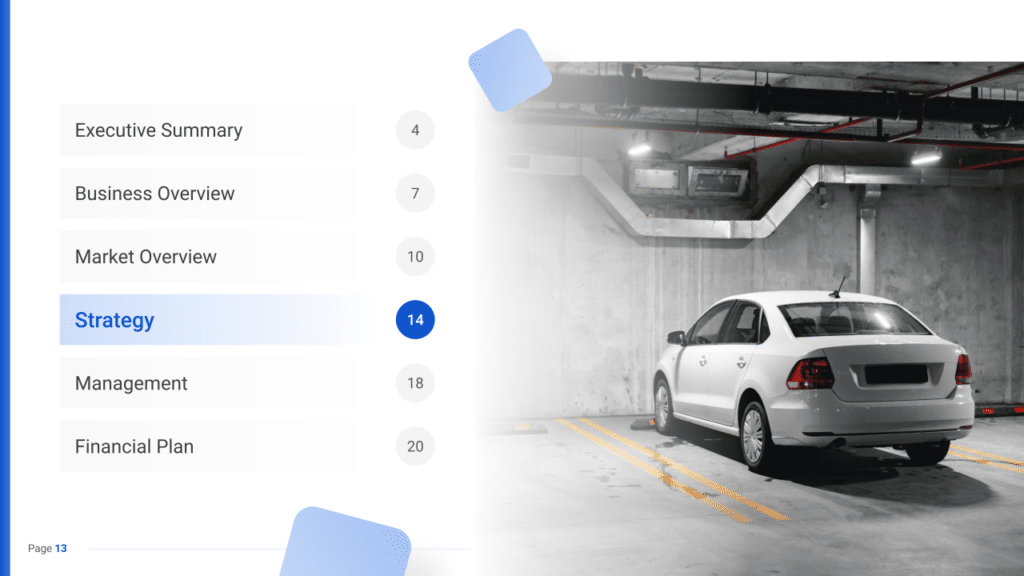
SWOT
First, perform a SWOT analysis for the car parking business, identifying Strengths (such as prime location and advanced security features), Weaknesses (including limited parking spaces or high maintenance costs), Opportunities (for instance, the increasing demand for parking in urban centers), and Threats (like the rise of ride-sharing services reducing the need for parking).
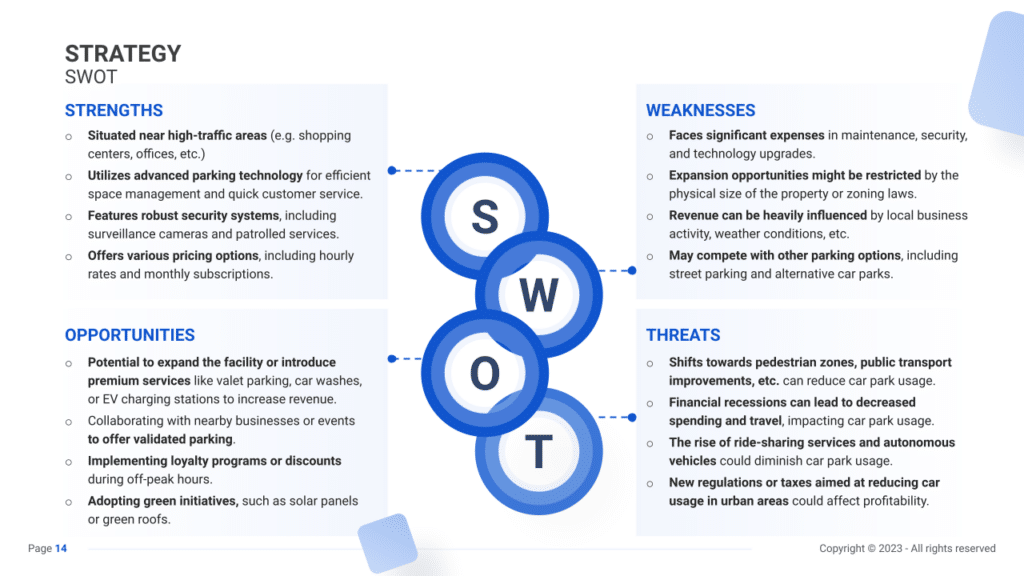
Marketing Plan
Next, devise a marketing plan detailing strategies to attract and retain customers through targeted advertising, competitive pricing, loyalty programs, and by leveraging technology for ease of use and convenience.
Marketing Channels
Utilize diverse marketing channels to communicate your brand and services effectively to potential and existing customers.
Digital Marketing
- Website and SEO: Develop a user-friendly website providing comprehensive information about your parking services, pricing, booking options, and contact details. Optimize the website for local SEO to ensure it ranks high in search engine results for parking-related keywords in your area.
- Social Media Engagement: Utilize various social media platforms like Facebook, Twitter, Instagram, and LinkedIn to engage with customers. Share updates about parking deals, safety measures, customer testimonials, and parking tips to maintain an active online presence.
- Email Marketing: Build an email subscriber list through your website or social media. Send regular newsletters containing parking tips, exclusive offers, upcoming events, and new service announcements to keep customers informed and engaged.
Local Advertising
- Flyers and Print Media: Distribute eye-catching flyers to nearby businesses, hotels, and event centers. Advertise in local newspapers or magazines that cater to a relevant audience interested in parking solutions.
- Sponsorships and Partnerships: Collaborate with local businesses, event organizers, or tourist attractions for sponsorships or mutual promotional activities. These partnerships can include offering discounted parking to customers of partner businesses or sponsoring community events for increased brand visibility.
Promotional Activities
- Special Deals: Launch promotional campaigns such as ‘Early Bird Discounts,’ ‘Weekend Parking Specials,’ or ‘Holiday Season Offers’ to attract different customer segments and encourage parking during specific periods.
- Loyalty Programs: Implement a loyalty program that rewards frequent parkers with benefits like free parking days, priority parking slots, or discounts on additional services after a certain number of visits.
- Referral Incentives: Encourage customers to refer friends or colleagues to use your parking services by offering rewards or discounts for successful referrals. Word-of-mouth referrals can significantly impact customer acquisition.

Sales Channels
Optimize sales channels to maximize revenue and enhance customer satisfaction.
Parking Facility Optimization
- Upselling: Enhance the customer experience by offering premium services like covered parking, valet services, or priority parking slots for an additional fee. These add-ons cater to customers seeking added convenience and comfort.
- Amenities and Additional Services: Sell car care services, charging stations, or convenience items like umbrellas, mobile phone charging ports, or car fresheners within the parking facility. Providing these amenities adds value and convenience for customers.
Online Booking and Sales
- User-Friendly Booking System: Implement an easy-to-use online booking system accessible through your website or a dedicated mobile app. Offering incentives like discounted rates or priority parking slots for online bookings encourages customers to use this convenient service.
- E-Commerce Integration: Sell parking passes, subscriptions, or exclusive access cards through your online platform. This additional revenue stream allows customers to purchase parking options in advance or for specific durations.
Membership and Loyalty Programs
Encourage repeat business through loyalty programs tailored to customer needs:
- Membership Options: Create membership programs offering monthly or yearly parking passes with added perks like discounts on additional services, exclusive access to premium parking areas, or priority slots during peak hours.
- Loyalty Rewards: Establish a digital loyalty program where customers earn points for every parking payment. These points can be redeemed for free parking days, upgrades to premium parking, or discounts on other services.
Strategy Timeline
Lastly, construct a detailed timeline that highlights key milestones for the car parking business’s launch, marketing initiatives, customer growth, and potential expansion plans, ensuring the business progresses with defined goals and objectives.

Management
The Management section focuses on the car parking business’s management and their direct roles in daily operations and strategic direction. This part is crucial for understanding who is responsible for making key decisions and driving the car parking business toward its financial and operational goals.
For your car parking business plan, list the core team members, their specific responsibilities, and how their expertise supports the business.
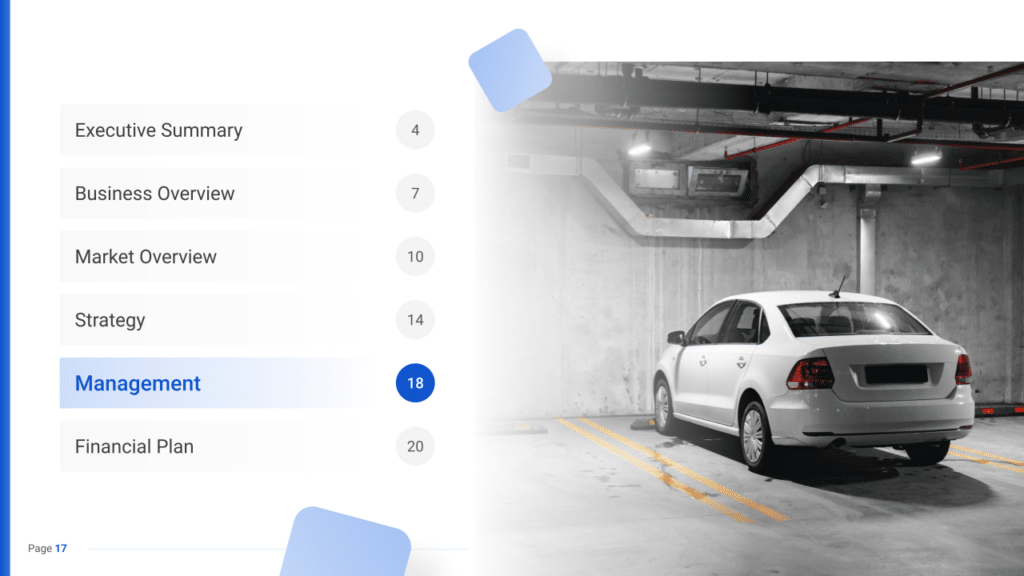

Financial Plan
The Financial Plan section is a comprehensive analysis of your financial projections for revenue, expenses, and profitability. It lays out your car parking business’s approach to securing funding, managing cash flow, and achieving breakeven.
This section typically includes detailed forecasts for the first 5 years of operation, highlighting expected revenue, operating costs and capital expenditures.
For your car parking business plan, provide a snapshot of your financial statement (profit and loss, balance sheet, cash flow statement), as well as your key assumptions (e.g. number of customers and prices, expenses, etc.).
Make sure to cover here
_ Profit and Loss
_ Cash Flow Statement
_ Balance Sheet
_ Use of Funds
